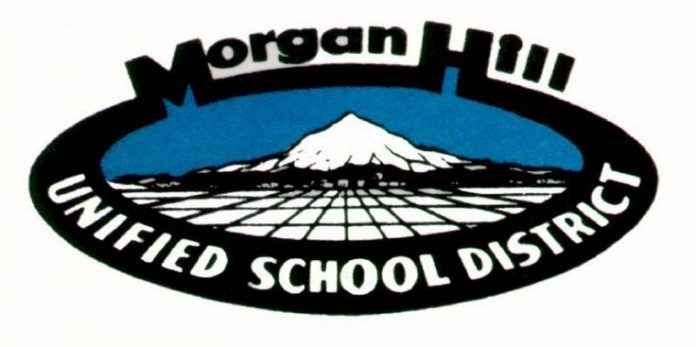School officials must mine their way through $5.5 million in budgetary cuts unless they can generate more revenue to offset the district’s deficit spending that began last year, according to a “Right Sizing the Budget” presentation at a board of education meeting earlier this month.
A combination of both cuts and more revenue is a more preferred scenario for district leaders who are seeking new funding streams such as placing a parcel tax on the June 2018 election ballot that could produce around $1.5 million annually at $75 per parcel.
District staff is awaiting the state budget in January to crunch the numbers and see how much, if any, cuts or increased revenues will be necessary to balance MHUSD’s budget for the 2018-19 school year.
Last year was the first time in the last five years that Morgan Hill Unified School District spent more money to run the district than what was coming in, Assistant Superintendent Kirsten Perez said at the Sept. 15 board of education meeting.
Three-year financial projections show a deficit of $4.42 million in the 2017-18 school year operation costs with $90,716,199 in expenditures compared to $86,294,270 in revenues; $5.63 million in 2018-19 with $92,394,063 in expenditures and $86,763,007 in revenues; and $3.37 million in 2019-20 with $94,490,817 in expenditures compared to $91,123,941 in revenues. Projections are based on assumptions provided by the Santa Clara County Office of Education, School Services of California, Inc., and Fiscal Crisis and Management Assistance Team.
“Failure to minimize the deficit spending could jeopardize the financial standing of the district, including its ability to meet the recommended minimum reserve for economic uncertainties,” according to district staff.
Over the same three years, the district’s available reserve reduces from 13.54 percent of the overall budget in 2017-18 to 7.12 percent in 2018-19 to 3.16 percent in 2019-20.
MHUSD Board Policy mandates a 16.67 percent reserve to ensure the district meets its financial obligations. However, the state requires a much lower 3 percent reserve minimum, according to Perez’s budget presentation. The three-year financial projections “show that the district will still exceed the state reserve requirement in all years; however the district would fall below the board’s reserve requirement.” Therefore, district officials have begun to “develop a plan to recover the fund balance.”
Different funding sources for district
While new funding sources are continually researched and a parcel tax measure is in the works, existing “revenue drivers” that the district wants to stress the importance of are enrollment and Average Daily Attendance. The more students are enrolled in local schools, the more money the district receives. But each day a student misses school, for whatever the reason, the district loses $60 per student. Other increased revenue could come in from things such as more students purchasing school lunches.
A series of six committee meetings are planned with various stakeholders, including faculty, parents and even students, to meet the problem head on. They will cover the district’s budget and targets, and then review specific budgets for administration and special education; facilities and operations; and instruction and related services. After that, the committee will formalize a preliminary list of budget reductions before finalizing it in February 2018, according to the staff report.
The governor’s state budget, which includes public education, comes out in January. Districts base their targets on assumptions that could differ from the upcoming state budget.
Trustee Gino Borgioli requested at least one board member be part of this committee. However, Superintendent Steve Betando and Perez explained that the board is involved with the district’s regular budget committee and this is an outreach piece of that same body.
“This could be a really serious thing going forward and I want to make sure that we are included in the plan as this thing goes,” Borgioli said.
While budget deficits and cutbacks are never easy, Betando said the district should use this budgetary challenge as an opportunity to educate the community and show them what they do. Staff and stakeholders will have to evaluate the district’s cache of programs and determine each one’s effectiveness and overall importance.
“Everything has a cost. There’s nothing that we do that isn’t some sort of cost….We have to see what’s not working and use that money to put back into the budget,” Betando said. “We have to look at this process as an opportunity to educate and engage.”
Trustee Mary Patterson was pleased that district staff is taking on these budgetary shortcomings at their infancy. “I’m pretty comfortable with this timeline,” said Patterson, who also requested monthly updates on the budget situation. “We’re focusing so much on reductions. I really want to keep us focused on revenue enhancements.”
District planning for parcel tax
According to district staff, parcel taxes are in place for 22 of 32 school districts within Santa Clara County; 16 in San Mateo County; 15 in Martin County; 14 in Los Angeles County; 11 in Alameda County; 10 in Sonoma County and nine in Contra Costa County.
Earlier this month, the board approved a $20,000 consulting contract with TBWB Strategies for parcel tax consulting services to help with the process of presenting it to the community. They will hear back from district staff in the coming months on how the process is proceeding.
In June 2017, parcel tax polling of 400 local potential voters was conducted by a different firm, Gene Bregman & Associates, at a cost of $24,000. Those results “demonstrated that the community has a positive opinion of MHUSD, respondents are supportive of local public schools and programs within the district, and a majority are willing to vote for a parcel tax to support public education,” according to district staff.
The district previously sought approval for a parcel tax in June 2006, which was called Measure E, but the parcel tax was unsuccessful with only a 55.5 percent approval rate. A parcel tax requires a two-thirds approval rate.
A parcel tax is a form of property tax assessed at a rate based on the characteristics of a “parcel,” rather than on the assessed value of the property, which is the standard method for levying property taxes, according to ballotpedia.org. It can be used for any type of spending, including construction costs, employee salaries and other projects or needs.
(Three-year financial projections)
2017-18 school year
Costs: $90,716,199
Revenues: $86,294,270
Deficit: $4.42 million
2018-19 school year
Costs: $92,394,063
Revenues: $86,763,007
Deficit: $5.63 million
2019-2020 school year
Costs: $94,490,817
Revenues: $91,123,941
Deficit: $3.37 million








